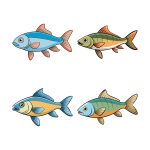1. Underestimating the Elements
New anglers often overlook just how unpredictable the weather can be, especially when youre spending hours outdoors. A clear morning can quickly turn into a windy afternoon or a chilly evening by the water. First-timers frequently make the mistake of dressing for only one part of the day, and that’s where discomfort—and even danger—can sneak in.
One of the most common errors is not wearing layers. Layering isn’t just about staying warm—it’s about flexibility. You want to be able to add or remove clothing as temperatures change throughout your fishing trip. Without layers, you could end up shivering from an early morning breeze or overheating under the midday sun.
Why Layering Matters
Layering helps regulate your body temperature and keeps you dry, both of which are key for comfort and safety. Here’s a simple breakdown of an ideal layering system for fishing:
| Layer | Purpose | Examples |
|---|---|---|
| Base Layer | Wicks moisture away from skin | Moisture-wicking T-shirt or thermal top |
| Mid Layer | Insulates and retains body heat | Fleece jacket, hoodie, or insulated vest |
| Outer Layer | Protects against wind and rain | Waterproof shell or windbreaker |
Dressing Smart for Changing Conditions
If youre heading out early in the morning, it might feel cold enough for a heavy hoodie. But as the sun rises, that same hoodie can leave you sweating and drained. Overdressing leads to heat exhaustion, while underdressing puts you at risk for hypothermia—even in mild weather if youre wet and exposed to wind.
Quick Tips:
- Always check the weather forecast before heading out.
- Pack extra clothes in a dry bag just in case conditions change.
- A lightweight rain jacket can be a lifesaver even on sunny days—it doubles as a windbreaker.
- A wide-brim hat and polarized sunglasses help with sun protection and visibility on the water.
The right clothing doesn’t just keep you comfortable—it lets you focus on what matters: enjoying your time on the water and catching fish.
2. Cotton Kills: Choosing the Right Materials
If youre new to fishing, you might think tossing on a comfy cotton hoodie and jeans is good enough for a day by the water. But heres the deal—cotton can be one of the worst choices when it comes to fishing apparel, especially if youre dealing with changing weather or cooler temperatures.
Why? Because cotton holds onto moisture. Whether its sweat, rain, or water from casting and handling fish, once cotton gets wet, it stays wet. That moisture pulls heat away from your body, which can leave you cold and uncomfortable—or worse, at risk for hypothermia in chillier conditions. This is where the saying “cotton kills” comes from in the outdoor world.
What to Wear Instead
The key is to wear clothing made from technical fabrics designed to manage moisture. These materials wick sweat away from your skin and dry quickly, helping regulate your body temperature and keep you comfortable throughout the day.
Recommended Fabric Types
| Material | Benefits | Best Use |
|---|---|---|
| Polyester | Lightweight, quick-drying, wicks moisture | Base layers, shirts, pants |
| Nylon | Durable, dries fast, wind-resistant | Outer layers like jackets and pants |
| Merino Wool | Insulating even when wet, breathable, odor-resistant | Socks, base layers in cold weather |
| Synthetic Blends | Balanced comfort and performance | All-purpose wear for variable conditions |
Dressing in Layers Is Key
A smart layering system includes:
- Base Layer: Moisture-wicking fabric (no cotton!) to keep sweat off your skin.
- Mid Layer: Insulation like fleece or wool to retain body heat.
- Outer Layer: Waterproof or windproof shell to protect against the elements.
This approach lets you adjust as temperatures change throughout the day—important when mornings are chilly but afternoons warm up quickly.
Quick Tip:
Always check the weather before heading out and dress accordingly. Even in summer, early mornings near the water can be brisk. Being prepared with proper layers made of technical materials will keep you safe and focused on enjoying your time fishing—not shivering through it.
![]()
3. Ignoring Footwear Functionality
When it comes to fishing, what you wear on your feet can make or break your day. Many first-time anglers show up in flip-flops or casual sneakers, thinking they’re dressing for a relaxing day by the water. But here’s the thing—fishing environments are often wet, muddy, and slippery. That comfy pair of shoes you wear to the grocery store? It wont hold up when youre standing on a slick riverbank or navigating a rocky shoreline.
Why Your Footwear Matters
Fishing often involves long hours of standing, walking over uneven terrain, or even wading into shallow waters. Without proper footwear, you risk more than just wet socks. You could slip, twist an ankle, or get cold and uncomfortable fast. That’s why experienced anglers invest in boots that are waterproof and have good grip.
Common Footwear Mistakes First-Time Anglers Make
| Footwear Type | Why It Fails |
|---|---|
| Flip-Flops | No grip, no foot protection, easily slip off |
| Canvas Sneakers | Soak up water quickly, offer little traction |
| Running Shoes | Not built for wet conditions, soles wear down fast on rough terrain |
What to Look for Instead
- Waterproofing: Keeps your feet dry even if you step in puddles or shallow water.
- Slip-Resistance: Essential for staying upright on wet docks or muddy trails.
- Ankle Support: Helps prevent sprains and offers stability on uneven ground.
You don’t need to spend a fortune—there are plenty of affordable options designed specifically for outdoor activities like fishing. Look for boots labeled “waterproof,” “non-slip,” and “all-terrain.” Investing in the right pair of boots not only makes your fishing trip more comfortable but also keeps you safe from avoidable injuries.
4. Neglecting Sun and Bug Protection
One of the biggest mistakes new anglers make is underestimating how harsh the elements can be—even on a seemingly mild day. Without sun-protective clothing, hats, sunglasses, sunscreen, and bug repellent, youre leaving yourself wide open to painful sunburns and relentless bug bites that can turn an exciting fishing trip into a miserable one.
Why Sun and Bug Protection Matters
When youre out on the water, theres usually little to no shade. The sun reflects off the waters surface, increasing your exposure to harmful UV rays. At the same time, many fishing spots—especially those near lakes, rivers, or marshy areas—are prime territory for mosquitoes, ticks, and other biting insects.
Common Issues Caused by Lack of Protection
| Without This | You Risk This |
|---|---|
| Sunscreen | Sunburn, skin damage, increased risk of skin cancer |
| Hat with brim | Sunstroke, face/neck sunburn |
| Polarized sunglasses | Eye strain, reduced visibility from glare |
| Bug repellent | Mosquito bites, tick exposure (which can carry Lyme disease) |
| Long sleeves/pants made of breathable fabric | Bites on arms/legs, more sun exposure |
Smart Gear Choices for Better Protection
- Sunscreen: Choose broad-spectrum SPF 30 or higher. Reapply every two hours or after sweating.
- UPF Clothing: Wear lightweight shirts and pants labeled UPF 50+ for full-day coverage without overheating.
- Wide-Brim Hat: Offers better shade than a baseball cap by covering ears and neck.
- Pheromone-Free Bug Spray: Effective repellents include DEET or picaridin-based options. Natural oils like eucalyptus are also popular.
- Polarized Sunglasses: Reduce glare so you can spot fish easier and protect your eyes from UV rays.
Dressing smart isn’t just about staying comfortable—it’s about staying safe. With a few simple additions to your fishing gear checklist, you can focus on enjoying your time on the water instead of swatting bugs or nursing a sunburn.
5. Overlooking Safety Gear Essentials
One of the most common mistakes first-time anglers make is underestimating the importance of safety gear. Whether youre fishing from a boat, a dock, or the shoreline, the right gear can make all the difference between a great day on the water and a dangerous one.
Life Jackets Aren’t Just for Kids
Failing to wear a life jacket while on a boat is a serious safety risk. Many new anglers assume that if they can swim, they don’t need one—but accidents happen quickly, and in cold or rough waters, even strong swimmers can get into trouble. U.S. Coast Guard regulations require life jackets on boats, but more importantly, they save lives.
When You Should Absolutely Wear a Life Jacket:
| Situation | Why Its Critical |
|---|---|
| Fishing from a small boat or kayak | These can tip over easily; you may not have time to react. |
| Cold weather or water temperatures | Cold shock can impair your ability to swim or stay afloat. |
| Fishing alone | No one else is there to help if something goes wrong. |
| Stormy or unpredictable weather | You could be thrown overboard by waves or wind. |
The Importance of Weather-Appropriate Outerwear
Ignoring the weather forecast or not packing proper outerwear is another mistake that affects both safety and comfort. A sudden downpour without a waterproof shell can leave you soaked and freezing. Hypothermia is not just a winter problem—it can happen in spring and fall too, especially when wet and exposed to wind.
Essential Outerwear for Different Conditions:
| Weather Condition | Recommended Gear |
|---|---|
| Rainy/Stormy | Waterproof rain shell with hood, quick-dry base layers |
| Cold/Windy | Insulated jacket, windproof outer layer, thermal gloves |
| Sunny/Hot | Lightweight long-sleeve shirt, wide-brim hat, polarized sunglasses |
A Little Preparation Goes a Long Way
If youre heading out to fish for the first time, take a few minutes to think through your gear list—not just tackle and bait, but what keeps you safe and comfortable. Being far from help means you need to be ready for unexpected situations. Pack smart, dress right, and always respect the water.


